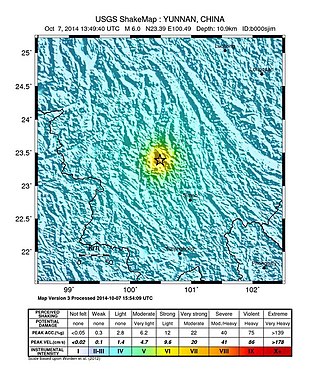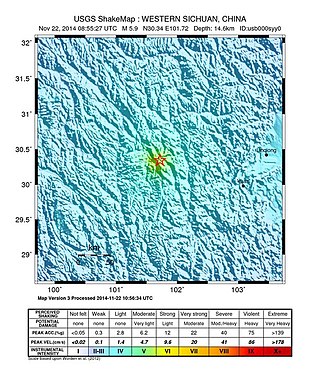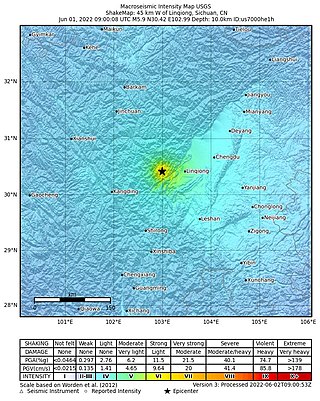
The 2008 Panzhihua earthquake struck southern Sichuan province, China on August 30 at with a surface-wave magnitude of 6.1, or 6.0 . It is also cited as the Renhe-Huili earthquake, especially in SCEA reports and early CEA reports. It was not an aftershock of the Sichuan earthquake that occurred several months prior. With more than 400 aftershocks, it caused over 40 deaths, the collapse of 10,000 homes and damage to other infrastructure in the provinces of Sichuan and Yunnan. The maximum liedu was VIII.
The 2008 Yingjiang earthquakes were a series of major earthquakes ranging from surface-wave magnitude (Ms) 4.1 to 5.9 that struck Yingjiang County, Yunnan province, China between August 19 and September 3. It caused 5 deaths, 130 injuries, and RMB 2.7 billion in direct economic damage. USGS put the magnitude of the strongest one to Mw 6.0.

Yiliang County is a county in the southeast of Yunnan Province, China, bordering the provinces of Sichuan to the northeast and Guizhou to the south. It is under the administration of the prefecture-level city of Zhaotong. In 2020 the population was 631,538 including 14.27% ethnic minorities, most of them Miao (59,920) and Yi (28,406).

Sani is one of the Loloish languages spoken by the Yi people of China. It is one of six Yi languages recognized by the Chinese government, under the name Southeastern Yi. Sani is spoken in Shilin, Luliang, Luxi, Shizong, Yiliang, Malong, Luquan, and Mile counties by about 120,000 speakers.
The 1948 Litang earthquake occurred on May 28, 1948, at 07:11 UTC. It was located near Litang, China. Now situated in the Sichuan Province, Litang County was then called Lihua (理化) County and belonged to the defunct Xikang Province. The earthquake had a magnitude of 7.2, or 7.3.
The 1998 Ninglang earthquake (1998年宁蒗地震) occurred on November 19 at . The epicenter was near the border between the provinces of Sichuan and Yunnan, China. The United States Geological Survey stated that the epicenter was located in the Sichuan Province, while the China Earthquake Data Center provided a different location in Lanniqing Township (烂泥箐乡), Ninglang, Yunnan Province. The magnitude of the earthquake was put at 6.2 and it caused five deaths, with 208 seriously injured in Yunnan and 20 people seriously injured in Sichuan. Building damage was reported in Ninglang, Yunnan and Yanyuan, Sichuan. A dammed lake was formed by a landslide in the Lanniqing Township.

The Lushan earthquake or Ya'an earthquake occurred at 08:02 Beijing Time on April 20, 2013. The epicenter was located in Lushan County, Ya'an, Sichuan, about 116 km (72 mi) from Chengdu along the Longmenshan Fault in the same province heavily impacted by the 2008 Sichuan earthquake. The magnitude of the earthquake was placed at Ms 7.0 by China Earthquake Data Center, Ms 7.0 by Russian Academy of Sciences, Mw 7.0 by Geoscience Australia, Mw 6.6 by the United States Geological Survey (USGS), Mw 6.6 by the European Alert System (EMSC) and Mj 6.9 by the Japan Meteorological Agency (JMA). 1,815 aftershocks have been recorded as of 00:00 (UTC+8h) April 22.

The 2014 Ludian earthquake struck Ludian County, Yunnan, China, with a moment magnitude of 6.1 on 3 August. The earthquake killed at least 615 people, injuring at least 2,400 others. At least 114 people remained missing. Over 12,000 houses collapsed and 30,000 were damaged. According to the United States Geological Survey, the earthquake occurred 29 km (18 mi) west-southwest of Zhaotong city at 16:30 local time (08:30 UTC).

The 2014 Jinggu earthquake occurred on October 7, 2014, at 21:49 (UTC+8).

The 2014 Kangding earthquake struck Kangding County, Garzê Tibetan Autonomous Prefecture, Sichuan, China, with a moment magnitude of 5.9 on 22 November. The earthquake killed five and injured 54 people.
The 2017 Jiuzhaigou earthquake occurred on 8 August 2017, in Zhangzha Town, Jiuzhaigou County, Ngawa Prefecture, Sichuan Province, China. The earthquake was registered at 7.0 and killed at least 25 people in the mountainous region of northern Sichuan.
The 1976 Longling earthquake in Yunnan Province, People's Republic of China, was a doublet earthquake, with two main shocks striking just east of Longling at 12:23:20 and 14:00:22 UTC. The magnitudes were estimated at 6.7 and 6.6, respectively, on the (GCMT) scale, and 6.9 and 7.0 on the scale; Chinese sources put these at 7.4 and 7.3 on the scale. The region is noted for the quantity and intensity of its earthquakes, and the complexity of its tectonics, which are closely related to the collision between the Indian and Eurasian tectonic plates.
The 2021 Maduo earthquake, also known as the 5.22 earthquake struck Madoi County in Qinghai Province, China, on 22 May at 02:04 local time. The earthquake had a moment magnitude and surface-wave magnitude of 7.4. Highway bridges, roads and walls collapsed as a result of the earthquake. According to an anonymous source, at least 20 people were killed, 300 were injured, and 13 were missing. Officials stated that there were no deaths but 19 people sustained minor injuries. It was the strongest in China since the 2008 Sichuan earthquake. It was assigned a maximum intensity of X in Machali, Maduo County on the China seismic intensity scale and Modified Mercalli intensity scale. This earthquake was preceded by another unrelated earthquake that occurred 5 hours earlier in Yunnan.
The 2021 Luxian earthquake was a damaging seismic event occurring in the early hours of September 16 at 04:33 China Standard Time. The surface-wave magnitude (Ms ) 6.0 or moment magnitude (Mw ) 5.4 earthquake struck at a shallow depth of 7.5 km and severe shaking in an area of 4,000 square kilometers was assigned a maximum intensity of VIII on the China seismic intensity scale. Three people were killed and 146 injured when the earthquake struck Lu County, Luzhou, Sichuan Province. At least 36,800 buildings were affected, 7,800 of them seriously damaged or completely destroyed, causing about a quarter of a billion dollars worth of damage.
The 2003 Dayao earthquake occurred on July 21, at 23:16:33 CST. The epicenter of the moment magnitude 5.9 earthquake was in Dayao County in the mountainous area of central Yunnan, China. At least 19 people were killed, 644 were injured, and 8,406 families became homeless. The quake also caused $75 million USD in damage.

On June 1, 2022, a moment magnitude (Mw ) 5.8 or surface-wave magnitude (Ms ) 6.1 earthquake struck Lushan County in Ya'an, Sichuan Province, China. At least four people were killed and 42 were injured. The earthquake had a maximum intensity of VIII on the China seismic intensity scale, causing damage to many homes and triggering rockslides.

A 6.7 earthquake struck Luding County in Sichuan province, China on 5 September 2022 at 12:52:19 local time. The epicenter was located 226 km (140 mi) from Chengdu, or 43 km (27 mi) southeast of Kangding. Ninety-three people died, 424 were injured and 24 remained missing. More than 13,000 homes and other infrastructure were damaged or destroyed. It was the largest earthquake to strike the province since 2017.

The 2019 Zigong earthquake occurred in Zigong, Sichuan Province, China, at about 13:00 on February 25, 2019. The epicentre was located in Rongxian County, with a magnitude of 4.9, a focal depth of about 5 km and a maximum intensity of VI. The earthquake killed two people and injured 12 others.

On 7 January 2025 at 09:05 CST (UTC+8), an earthquake measuring Mw 7.1 struck Tingri County, located in the Shigatse prefecture-level city of the Tibet Autonomous Region of Southwestern China. Between 126 and 400 people were killed and 338 were injured in the region. The earthquake also injured 13 people in Nepal and caused minor damage in Northern India. Shaking was felt across South Asia. The earthquake was the largest in China since the Maduo earthquake in May 2021 and the deadliest since the Jishishan earthquake in December 2023. It was caused by normal faulting and originated within the continental crust at 10 km (6.2 mi) depth.











